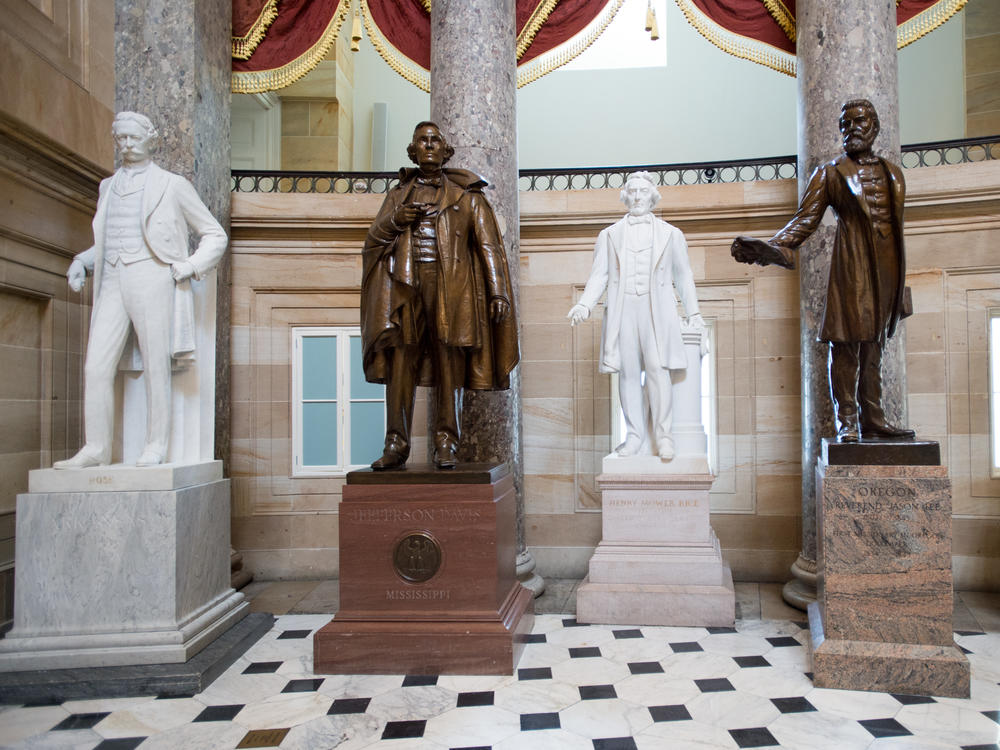Section Branding
Header Content
All But 5% Of U.S. Capitol Sculptures Are Of Men. Some Senators Want To Change That
Primary Content
Updated July 29, 2021 at 12:23 PM ET
Minnesota Democratic Sen. Amy Klobuchar sees one pretty obvious problem in the halls of the U.S. Capitol.
"You don't have to have a Ph.D. to walk around here and think, 'Huh, they're all men,' " Klobuchar says. "And that's just wrong."
In all, the Capitol has 266 sculptures — including statues, busts and monuments — honoring notable figures in history. Of those, only 14 are of women.
Now, Klobuchar and a bipartisan group of lawmakers are joining forces to change that, starting with introducing new legislation Thursday to add statues of the first two women to sit on the Supreme Court.
Klobuchar, the chair of the Senate Rules Committee, was approached this year by the family of the late Justice Ruth Bader Ginsburg, a meeting that sparked a plan to honor both the "notorious RBG" and the first woman justice on the people's court, Sandra Day O'Connor.
"When you get visited by Ruth Bader Ginsburg's daughter and granddaughter, and it's your first in-person meeting, during the pandemic, you kind of don't forget it," Klobuchar said.
Soon after, Klobuchar pitched the idea to her Senate colleagues on the upper chamber's floor at 3 a.m. after a long "vote-a-rama" session. Senate Minority Whip Dick Durbin, D-Ill., was by her side, jokingly spreading the word the plan was his idea.
"Because men never claim that it's their idea over a woman," Klobuchar said with a laugh. "So we walked through the chamber, and got a bunch of people on board."
Now, 20 senators, including more than a dozen Democrats and three Republicans, are on board. GOP Sens. Lisa Murkowski of Alaska, Susan Collins of Maine and Shelley Moore Capito of West Virginia have signed on so far.
"Obviously they are pioneers, and I think it would send a great message to all the young girls who go through the Capitol," Capito says of the potential new honors for O'Connor and Ginsburg.
The legislation will also be introduced in the House in the coming week.
Art as inspiration
The Capitol's existing collection includes sculptures of historic figures such as Helen Keller, Sakakawea and Rosa Parks.
Another piece in the collection is a statue of abolitionist Sojourner Truth, which was unveiled in a crowded ceremony attended by congressional leaders, White House officials and celebrities.
"It was a day of validation and gratitude," recalls Artis Lane, who sculpted the bust of Truth.
That was more than 10 years ago, in 2009.
Lane, who is now 94, says the gap that has largely followed since is part of a long history in art that has often left women behind. As a Black woman herself, Lane says she faced racial abuse and bigotry throughout her life and career.
"So how could it surprise me?" Lane said.
But lawmakers like Klobuchar and Capito argue that their legislative endeavor could be part of a larger effort to tell a more inclusive story of women through the Capitol's art collection.
It's a sentiment that perhaps Ginsburg herself might agree with, as she touched on the power of legacy in a 1975 interview with NPR.
"And when you see women doing so many different things in the law," Ginsburg said, "then you believe, well, maybe there'll be a place for me, too."
The Capitol's art collection is in flux
In the past year, certain pieces of the Capitol's art collection honoring Confederates and other controversial figures have drawn fire. Some are already in the process of being replaced with women, which would bring the 14 featured today to at least 20.
For example, the Capitol's National Statuary Hall collection, which is comprised of 100 statues — two from each of the 50 states — will see Virginia replace its statue of the Confederate General Robert E. Lee with civil rights icon Barbara Johns.
More changes could come. One of the statues that Capito's home state of West Virginia contributed is of John Kenna, a Confederate figure.
"I would say that the status of some of the statues is sort of in flux," Capito says. "I would hope that they would consider certainly our state, if we replace one of our statues, would consider one of our strong females."
For example, Capito suggests the late NASA mathematician Katherine Johnson, the West Virginian whose story was featured in the 2016 film Hidden Figures.
Jacqueline "Jacki" Musacchio, a professor of art at Wellesley College, says it's not difficult to find historic women to honor through art.
"We don't have to reach very far to find out that there were incredibly important women that did amazing things in the United States' history," Musacchio said.
Musacchio calls the scarcity of women featured in the Capitol's art collection "depressing." And although public tours are not currently allowed today as a result of the coronavirus pandemic, these changes can have an immense impact when they return, Musacchio said.
"When you think about the school groups and everyone else who goes on tours of the Capitol," she said, "this is a chance to show them the history of these women and to show the place of women in history."
Copyright 2021 NPR. To see more, visit https://www.npr.org.
Bottom Content

